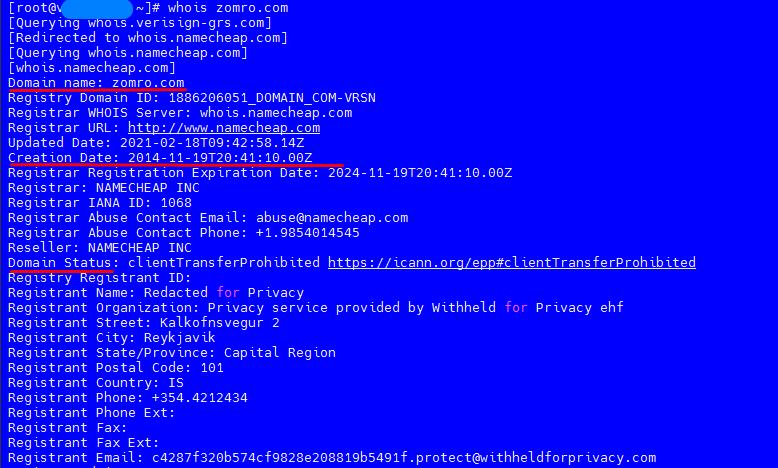Description of the use of the command and its application.
The whois command can be useful in many situations related to checking information about domains. On Linux, the `whois` command is used to get information about domain names, IP addresses, and other entities on a network.
1. Checking the domain status if the domain is down:
If the domain is down (for example, the website is not opening), you can use the `whois` command to find out the current status of the domain. The status can indicate why the domain is temporarily unavailable. For example, the status `clientHold` or `serverHold` may indicate that the domain has been suspended for some reason. You can use the `whois` command to find out if a domain is active or if there are any issues with its status.
2. Checking the Name Server if the domain is down:
If the domain is down, it may be due to incorrect values or entries on the Name Server side. The `whois` command can show which Name Servers are associated with a domain. This can be useful for determining whether domain unreachability errors are related to its nameservers.
3. When the domain expires, you need to renew or you need to buy a domain in the future that is still valid:
The `whois` command allows you to find out the expiration date of a domain. This is important to know when a domain will become unavailable if it is expiring. If you need to renew or buy a domain, you can use the expiration date information to decide if you need to take immediate action to purchase it. If you use your API, you can check domain statuses and expiration dates and renew them, or make purchase requests for desired or interesting domains.
`Whois` command
To view information about a domain using the `whois` command, follow these steps:
1. Open a terminal: Press the `Ctrl + Alt + T` keys (usually) to open a terminal window, or start a console.
2. Enter the whois command, specifying the domain name you are interested in.
whois zomro.com
After typing the command, press the "Enter" key to execute the `whois` command. The output of a `whois` command with a domain name such as zomro.com would be:

3. Wait for results: The `whois` command will query the WHOIS database for the requested domain and return information about the domain such as owner, contact details, registration and expiration dates, DNS servers, and other related data.
An example output might look like this:
```
Domain Name: EXAMPLE.COM
Registry Domain ID: 123456789_DOMAIN_COM-VRSN
Registrar WHOIS Server: whois.example.com
Registrar URL: http://www.example.com
Updated Date: 2023-07-15T10:00:00Z
Creation Date: 2000-01-01T00:00:00Z
Registrar Registration Expiration Date: 2024-01-01T00:00:00Z
Registrar: Example Registrar, Inc.
IANA Registrar ID: 1234
Registrar Abuse Contact Email: abuse@example.com
Registrar Abuse Contact Phone: +1.5555555555
Reseller:
Domain Status: clientTransferProhibited http://www.icann.org/epp#clientTransferProhibited
Registrant Organization: Example Company
Registrant State/Province: NY
Registrant Country: US
Name Server: NS1.EXAMPLE.COM
Name Server: NS2.EXAMPLE.COM
DNSSEC: unsigned
URL of the ICANN WHOIS Data Problem Reporting System: http://wdprs.example.com/
>>> Last update of WHOIS database: 2023-08-23T00:00:00Z <<<
```
Please note that the specific output format and available information may vary depending on the registrar and domain name settings.
Display only important information.
Since the whois command gives a lot of information, you need to filter and leave the most important one. To do this, grep with the -iE options filters lines containing the keywords "Status", "Exp" (Registry Expiry Date) and "Name Server", displaying only the necessary information. If the short whois output didn't include "Name Server", replace "Name Server" with "NS". Perhaps this field or line with "Name Server" is called differently by another registrar.
whois zomro.com | grep -iE "status|exp|name server"
The output of important information will be like this:

Results.
The `whois` command provides valuable information about a domain, its status, nameservers, and expiration date. This can help you understand the cause of domain availability errors, plan to purchase a new domain, or clarify details about existing domains.

